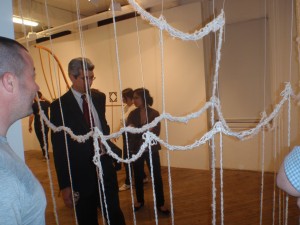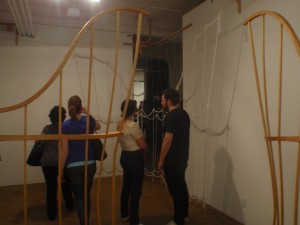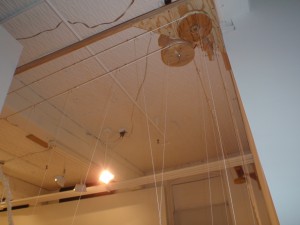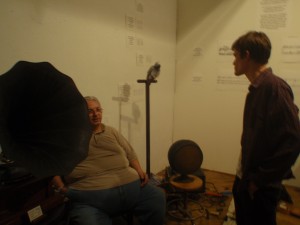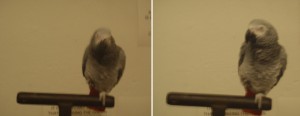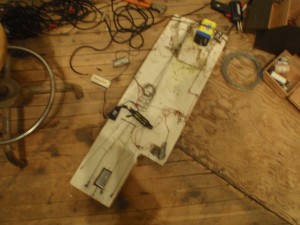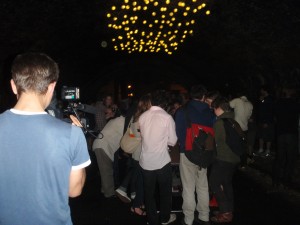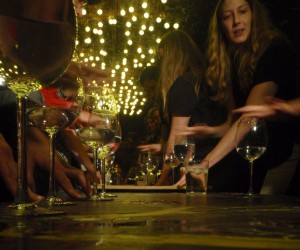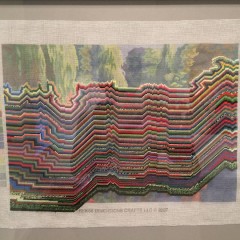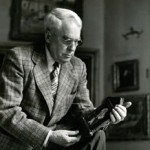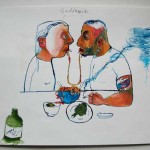The Collective Spaces at 319 N. 11 St. were teeming with activity last Friday night – openings at Vox, Copy Gallery, Tiger Strikes Asteroid, and a new space called ‘Progressive Sharing‘ that just opened on the 6th floor of the building.
Secret Passage by Charles Hobbs, on display at Vox, is a somewhat awkwardly choreographed interactive piece. As one approaches the opening to the exhibit a large, almost surreal twisted gate structure is immediately viewable, inhabiting the center of the room. As one draws nearer to this large structure, the inner-workings of the exhibit begin to expose themselves. The entryway into the exhibit can only be traversed by navigating through a slowly moving mesh-like curtain which is rigged around the room on a motorized pulley system. The result of this contraption is at once both restrictive and engaging – as the curtain moves into a closed position across the doorway, the choice to enter the space (or leave for that matter) is no longer available.
Unfortunately aside from the striking central gate-object which severs to initially draw the viewer in, there is not much else engaging once you’ve successfully entered the space, resulting in a backup trying to both enter and leave through the blocked opening.
The back-up creates a forced experience between viewers, as people wait to be released or permitted entry by the delicately moving curtain. It also creates a rather timid dance as people flow in and out of the exhibit at regular intervals as the curtains open and close. The result is a displacement of the viewer, as she realizes the restrictions this exhibit places on her viewership. This displacement is nicely complemented by the eerie dream-like quality of both the central gate-object and the mechanical curtain, as well as the background of theramin-generated lulls and the squeaking along of the pulley system.
This eerie displacement continued up on the sixth floor with the opening of Music and Sound in Progressive Sharing, a gallery space started by Maggie Manzer. This space seemed curated to transport the viewer into a dream-like state (or perhaps it was more a result of the great beer selection at the Vox opening and all the Twin Peaks I’ve been watching). As in the Secret Passage, music plays a central role in the exhibit, and it was also the subject of the piece displayed on the walls. This display was less interesting, however, than the richly-real experience unfolding in the space.
As you enter, there is music being played from an antique Victrola accompanied by its owner and operator. To his left sits a parrot atop a wooden perch. When I inquired with the man if that were his parrot, he responded, ‘No, this is my Victrola that’s his parrot.” indicating the man across from him (pictured above) who was apparently part of the orchestration of this experience.
The artist told that the man that he was free to go as the hour was getting late, but the man seemed insistent to stay and accompany his Victrola until the end. Moving around the room one encountered various contraptions and exposed wires, related to the experiment with sound that was the subject of the opening.
I think the success of this work was perhaps less in what it intended – the experiment with music and sound – as it was in the realness of experience it created, especially when approximated by the work that is on display a few floors down in Vox.
Before I had more time to investigate the specifics of the music theory displayed on the walls in Music and Sound, an event began unfolding downstairs. It was another eerie choreographed experience; descend the stairs, migrate across the street towards the light emanating from yellow bulbs suspended at the tunnel’s ceiling under the tracks.
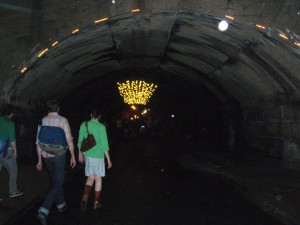
There everyone gathered around a table set with a number of crystal wine glasses full of water.
Each person individually wet their finger, and began to circle the rim of the glass. The moaning of the reverberation from the glasses started out softy, then grew and morphed as more people joined in, and filled the space. Coupled with the faint echo of the tunnel, and the dramatic soft light cast by the bulbs overhead, the sound created an engulfing other-worldly experience.
The seamless orchestration of this symphony was rather impressive, the doings of Mike Fleming and Ryan Hinkel in conjunction with the piece on display upstairs at Progressive Sharing. The performance recalls the ‘Happenings’ of the late 1950s and early 1960s, and the discordant and unfamiliar sounds emanating from the glassware seem to reference the work of John Cage, one of the originators of those performances. The new idea in this piece lies in the artfully-intentioned way it was initiated and performed. Earlier in the night, walking through the galleries, randomly scattered informational diagrams of how to make sound emanate from the top of a wine glass were posted throughout the space. Despite all the times I walked past and noticed the poster out of the corner of my eye, I never stopped to actually read it. But its clean ‘visual-diagram’ style and repetition of placement in the exhibition space were enough for me to connect the two immediately, unconsciously as the performance began with the migration downstairs.

I am thrilled with Progressive Sharing’s experiments with-in and outside-of the traditional gallery space and am looking forward to seeing more from them. Their thoroughly effective method of urging a happening suggests to me that looking at art in Philly is no longer so straightforward as it might seem. Everything in the Collective space becomes on display, including the artists working spaces, which lurk at right angles all throughout the building. Hints at what might unfold populate the space, and are as much part of the opening as the exhibits on display. This communal approach to exhibition space, studio space, and what becomes performance space has a lasting impact. The net result is that the work further removes itself from the white walls to go up the wooden stairs, around the corner, into a studio space (wrong turn), back down the stairs across the street and under the train tracks.



